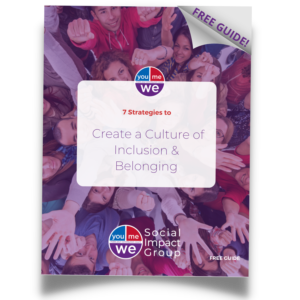7 Strategies to make your team’s meaning memorable and sustainable
Connecting your colleagues to what they care about, addressing what the world needs, utilizing their strengths, talents, what they enjoy, and creating a social initiative that allows for an environment where they can excel ……are progressive steps to providing a more meaningful experience at work is fabulous.
However, if it is not coupled with the proper structure, leadership, or collaboration skills, the sizzle may fizzle out in relatively short order.
How to structure and collaborate in your social initiative will be further discussed in due time. If you stick with the Nobody Wants to Work Series, you will continue focusing on conscious leadership and how it dives deeper into why nobody wants to work and how those same skills will assist in making a collective social impact.
For now, let’s stay the course to sustainability.
by Suzanne F. Stevens, Conscious Leadership and Social Contribution Cultivator, Founder, YouMeWe Social Impact Group Inc. Part of the Nobody Wants to Work Series.
Use talents to make your contribution count.
I can’t help but reflect on a rafting trip down a rapidless river when considering this principle. Before our departure, the guide instructed us, “If you fall out of the boat and get stuck under it, don’t panic. Walk your hands along the bottom of the raft and continue in one direction. Don’t lose patience and start turning around in a different direction — you will start going in circles, leaving you exasperated and under the boat.”

Great advice for many situations.
When making a conscious-contribution™, it is most efficient to continue in one direction — in other words, to make it consistent and focused; this will offer the most significant impact on the beneficiary and on your team’s gratification. However, there are times we can get distracted by the latest opportunity and, in doing so, dilute our contribution impact.
Continuing in one direction means not deviating from your social mission.
The YouMeWe Foundation learned the wisdom of the rafting guide firsthand. Although we were focused on raising funds to provide university scholarships, there was a new opportunity in town that friends were supporting — building a Women’s Center at a university. I wanted in. Under the raft I went, not having the wisdom of my guide, I was stuck going around and around unfocused.
After two years, the ground for the center still wasn’t broken. The charity I funneled my fundraising funds to stepped in. They redirected the monies to scholarships for deserving women.
Having the courage to expand is admirable, but first, a contribution needs to be entrenched before you deviate. Without a strong foothold into contributing to what and whom you care about (your compassion-connection™), you will sabotage your efforts, minimizing your gratification and beneficiary benefits.
There are several strategies to consciously connect and commit to a cause that you may want to consider as you create a more meaningful workplace. (Say that five times fast).
STRATEGIES to consciously connect and commit to a cause
1. Select a complementary cause
What is an issue that your business is experiencing, i.e. finding talent? Perhaps you can interview new immigrants from war-torn countries?
 What challenge is your community facing that your business serves? Perhaps you’re a retailer, and you have clothes from last season (Ok, a few seasons before. Let’s face it, most of us can’t afford to keep up on all the latest trends). You can host a fashion show where attendees can buy an outfit for a woman entering back into the workforce. Creating an experience is a wonderful way to address an issue that will be sustainable because your customers are engaged and using their dollars to support it.
What challenge is your community facing that your business serves? Perhaps you’re a retailer, and you have clothes from last season (Ok, a few seasons before. Let’s face it, most of us can’t afford to keep up on all the latest trends). You can host a fashion show where attendees can buy an outfit for a woman entering back into the workforce. Creating an experience is a wonderful way to address an issue that will be sustainable because your customers are engaged and using their dollars to support it.
Contribute to an issue your industry perpetuates. I.e. Paper producer or retailer? Plant trees. In the meeting industry? Support professionals against human trafficking (http://www.mpaht.com/).
2. Converge causes the team cares about
Because the YouMeWe Foundation Provides scholarships for post-secondary education in Africa, I interviewed my team about a local initiative that would appeal to them. They decided on literacy. I collaborated with Frontier College – which promotes literacy for underserved communities. I wanted to stay aligned with my foundation mandate of Women Empowerment. So, we created an initiative where a portion of my business funds mobilized young women in post-secondary education. As a result, students gained exposure to Indigenous communities and immigrants, providing increased consciousness and leadership skills.
To enhance the experience for my team and the students we supported, we could have invited them to a conference we hosted, where the mentorship opportunities are endless.
3. Value and mission alignment
In the previous example, literacy worked for my organization because my company at the time focused exclusively on training influential communications. Our mission was to develop leadership, sales, presentation, and internal communication skills to create impactful conversations to establish symbiotic partnerships.
exclusively on training influential communications. Our mission was to develop leadership, sales, presentation, and internal communication skills to create impactful conversations to establish symbiotic partnerships.
4. Commit to that Cause
In addition to the opening anecdote, once you land on a company cause, bake it into your business by incorporating it into your mission and business plan. This will assist with focusing all your activities, marketing efforts, and hiring practices, such as drawing well-aligned valued colleagues to your organization.

At the outset, articulating an impact statement will guide all your strategic efforts. An impact statement focuses on the effect you are going to generate. It incorporates what you will achieve (outcomes), for whom (beneficiary), and by when (timeframe); the more specific the statement, the more directed your efforts.
5. Communicate the Cause
Decide, do, impact and share. The more your team is committed to the cause understands it, and owns it, the more they will share it. As a matter of fact, I was on a website today diving into a cause, and who did I see on the home page? One of my dearest friends! I had no idea she was an advocate for this cause!
It should be part of your brand story when you make a social impact. Something you amplify at every opportunity. If you want real change for the marginalized, vulnerable, underrepresented, or environment, then share what action you are taking and the impact your team is making.
Craft a message that your colleagues can share with pride. These are not values to hang on a wall for people to walk by but an aspiration to be pridefully shared. It is an extension of your value proposition amplified in every conversation with suppliers, clients, customers, associates and, yes, friends :). People will be inspired and perhaps even become clients. So, share what, why, and how you support social initiatives so you can collaboratively grow your impact.
6. Supplier Selection
How committed are you to your social initiative?
How value-aligned do you want your suppliers to be?
The more obvious response is to hire, buy from, or engage the supplier that is already incorporating practices aligned with your values, i.e. create a diverse and inclusive culture.
However, there is an argument to engage suppliers whose values don’t align. Perhaps by engaging not wholly inline values, there is an opportunity to educate, inspire, and, well, frankly expose them to a more inclusive way to conduct business. As a result, creating a ripple effect. Perhaps this approach may be one of the measures of your social impact.

So, decide if you want your suppliers’ values to align before working with them, or do you see it as an opportunity to expose them to your values?
For example, if you are being conscious of carbon omissions and your supplier is not environmentally aligned, do you engage with them or see it as an opportunity to educate?

In interviewing Natalie Lowe, an environmentalist and meeting planner, she chooses the latter (to check out her interview, visit https://podcast.youmewe.ca/natalie-lowe-sustainable-event-forum/
Many businesses, however, will want to engage suppliers whose values align. You will have to do some due diligence to ask questions to expose how they conduct business so that you are not operating blindly. Ideally, you don’t want to engage a supplier contradictory to your Cause. I.e., you’re promoting diverse entrepreneurship. They hire all volunteers as interns in the summer – limiting diversity – as many diverse people may not be able to afford to “volunteer” for the summer, as they need to make income to pay for that business degree.
Through questioning, you will increase your consciousness and be able to assess the right partners.
7. Measure what matters
Measurement can seem cumbersome, especially if your sole motivation is to engage your colleagues. However, keeping track of your impact will further make your organization sticky. Your team will acknowledge the authenticity of the collective contribution and continue to connect to its increased impact.
Write a Theory of Transformation identifying the approaches needed to achieve desired goals. A theory of transformation is a gauge to measure the progress between strategies implemented, the performance expected and results realized. Developing a logical model that will identify progression on your social impact journey will feel rewarding to be involved at each of the milestones.
Nothing like celebrating with your team the collective contributions!

Example: Measure your footprint
When your team wants to make their contribution count while they work, there are many elements to think about. More often than not, it starts with a conversation about who or what they connect to and if and how they want to make that connection count.
What can you do now to make your contribution count?
Engage your team in a conversation about your collective values. When you founded your business, you likely identified values that you wanted at the core. However, with time and employee input, you may find those values have evolved. Or you may find people’s personal values have overtaken your organizational values. People’s personal values will usually be their default, whether you want them to be or not.
Gaining buy-in to a set of values will help define where and how you want to make your contributions count, a key strategy to connect people to where they work and contribute.
 Download 7 strategies to create a culture of Inclusion and Belonging. inspired by advocates, business, and community leaders on how to engage diverse talent.
Download 7 strategies to create a culture of Inclusion and Belonging. inspired by advocates, business, and community leaders on how to engage diverse talent.
At YouMeWe Social Impact Group, we grow conscious leaders and their social impact—sustainably. Subscribe to YouMeWe Infusion to make your contribution count for you, your organization, and your community.
P.S. do you have a question about growing your social impact?
Let me know in the comment
The article was originally posted by %author_name% Originally posted on%post_title%
. This article originally posted on Source